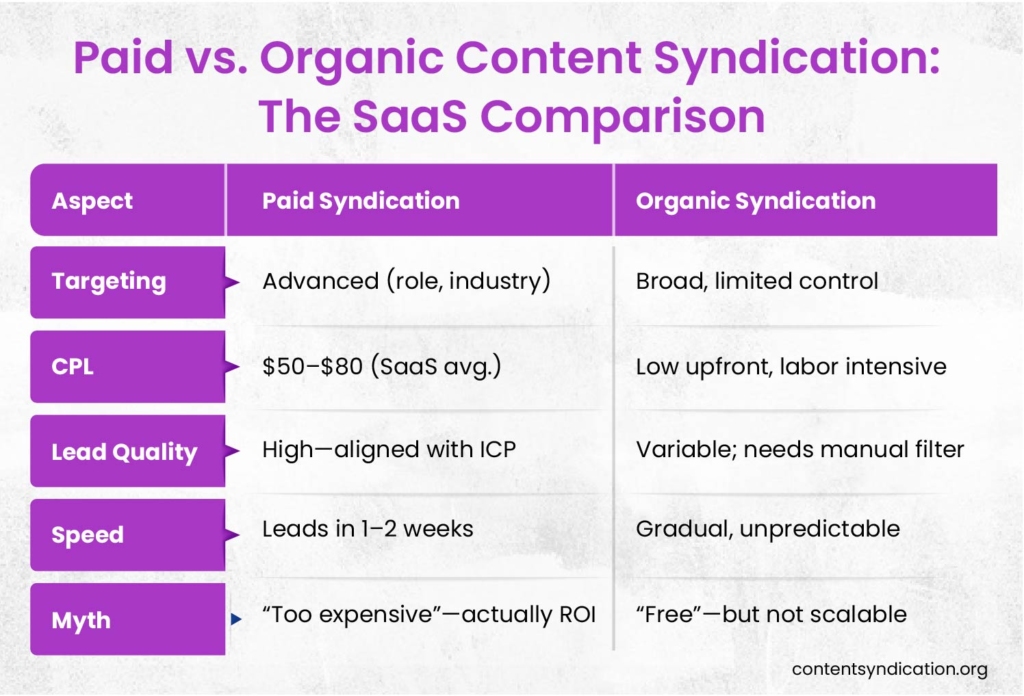Growing your SaaS startup? You have probably invested considerable energy into crafting valuable content: guides, case studies, webinars, and more.
But what happens when your target audience never finds that content? This is a fundamental challenge every SaaS startup faces. No matter how impressive your product is or how sharp your insights are, your pipeline will stall if you cannot get your message in front of the right people.
The struggle is only made worse by saturated and slow-moving organic channels. With limited brand recognition and an unpredictable SEO landscape, even the best teams see their content’s impact plateau.
For today’s research-driven SaaS buyers, great content is only valuable if it is seen at the right moment in their decision journey. Otherwise, even the most brilliant resources can feel futile.
What is Content Syndication in B2B SaaS
Content syndication is the strategic distribution of your content assets through trusted third-party sites or vendor networks. The goal here is to appear in front of the right, highly engaged prospects who match your ICP and are actively researching new solutions.
So how does it actually work?
How It Works: Paid vs. Organic Syndication

Organic syndication means publishing content on platforms like LinkedIn, Medium, Slideshare, or relevant industry blogs. Surely, you boost awareness and SEO, but it lacks precise targeting and lead capture.
Paid content syndication can be done on platforms such as TrustRadius, DemandScience, TechTarget, and LinkedIn partner networks.
These vendors help you hit your target. How? By promoting your content directly to filtered audiences, often via email or gated landing pages. This way, you generate qualified leads who have actively expressed interest.
This is straightforward. Your content gets featured on a partner’s website and is distributed via targeted emails.
Interested audiences fill out the forms, and these become your Marketing Qualified Leads (MQLs) for your sales and marketing team.
The best part is that your content is not limited to your own website but reaches people who are not aware of your brand. Maybe they are a strong fit, and maybe you are new to the market.
Many high-growth SaaS teams blend paid and organic approaches, using paid syndication to fuel MQL flow and organic syndication for brand and SEO lift.
Why Content Syndication Is Essential for B2B SaaS Startups
SaaS startups with small teams have limited brand recognition. Content syndication addresses these pain points by letting you:
- Rapidly expand your reach beyond your website
- Connect with in-market buyers who may not have heard of your brand
- Consistently generate qualified leads and accelerate your sales cycle
But does it give real business impact?
Absolutely. Research shows SaaS companies using syndication achieve about 30% more MQLs, with cost per lead ($50–$80) that surpasses most paid social or search channels.
Third-party content distribution is a game changer here. This is where you already hold buyers’ trust. Then you build credibility while nurturing multiple stakeholders involved in SaaS purchase decisions.
Crafting an Effective SaaS Content Syndication Strategy
So how do you map the content to the buyer journey?
Top of Funnel
Use educational guides and industry reports to attract buyers starting their research.
Middle of Funnel
Share webinars, frameworks, and checklists that demonstrate your expertise.
Bottom of Funnel
Offer ROI calculators and detailed case studies for buyers evaluating final options.
This way, you make sure that you are not just generating leads but providing real value at each stage, moving prospects closer to the decision stage.
Moreover, careful mapping closely aligns your syndication campaigns with sales and SDR outreach, with leads flowing smoothly from first touch to closed deal.
Quality Over Quantity: Getting the Most from Your Syndication Investment
SaaS marketers worry about lead quality, which is understandable. But this often happens when marketers rush into settling with syndication partners.
With the right partners, this risk is surely mitigated.
You should always define your ICP filters in detail — job function, industry, company size, and even geography — and require lead replacement if quality slips.
Do not overlook robust follow-up. Integrate the leads into your CRM and automate the nurture sequences. Ideally, fast and personalized follow-up outreach within 24 hours dramatically increases conversion rates. Scoring leads based on fit and engagement allows your sales team to focus effort where it counts most.
How to Choose the Right Syndication Partners
Your choice of syndication vendor can make or break your campaign. Look for partners who understand B2B SaaS and offer:
- Granular audience targeting (role, intent, company size)
- SaaS-specific references and proven results
- Transparent, real-time reporting on cost, conversion, and lead engagement
- CRM and automation integrations for instant follow-up
Do not overlook vertical communities like TrustRadius or technical forums, where SaaS buyers gather to research and compare solutions.
Measuring the True ROI of SaaS Content Syndication
The real value of syndication comes into focus when you track performance end to end. Beyond just cost per lead, monitor your:
- MQL to SQL conversion rates
- Pipeline and closed-won revenue attributable to syndication
- Engagement metrics like time on page and asset completion
Leverage multi-touch attribution in your CRM to understand how syndication supports longer, multi-stakeholder SaaS deals. Optimize campaigns as you go, refining filters, messaging, and content format for maximum return.
Your Next Steps to Turn Content Into Pipeline
Content syndication is not a tactic just for big brands. For SaaS startups looking to build a predictable pipeline, establish trust, and accelerate sales cycles, it is an essential growth lever.
Your path forward is clear. Audit your content for syndication readiness, clarify your ICP, pilot with two or three top vendors, and build automated nurture streams.
With the right approach, your next surge in high-quality leads and closed deals could be just weeks away.




